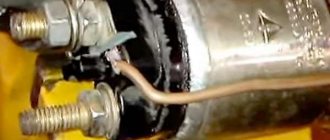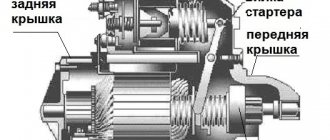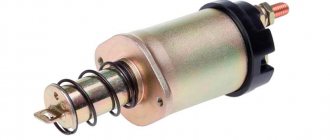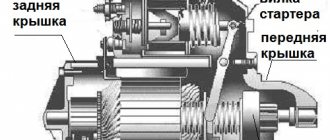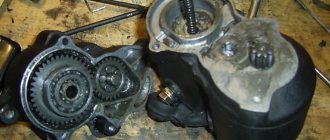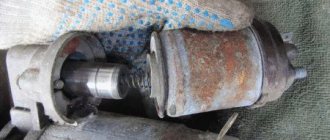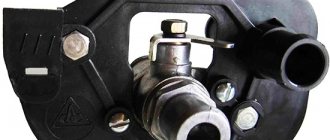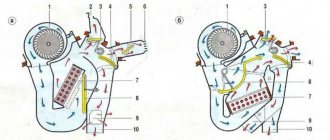Starter solenoid relay is an electromagnet that performs two functions in the ignition system. The first is to bring the Bendix starter gear to the flywheel ring gear. The second is its return to its original position after starting the engine. A breakdown of the solenoid relay may result in the engine simply won't start. There are not many reasons for relay failure. In this material we will try to describe the signs and causes of failure, as well as diagnostic and repair methods.
Solenoid relay with core
Operating principle of the solenoid relay
Before moving directly to the malfunctions and methods for eliminating them, it will be useful for car owners to know the device of the starter retractor relay and how it works. It is immediately worth noting that the mechanism is a classic electromagnet , consisting of two windings (holding and retracting), a circuit for connecting it to the starter, as well as a core with a return spring.
Scheme of operation of the solenoid relay
When the ignition key is turned, voltage from the battery is supplied to the coils of the solenoid relay. This creates an electromagnetic field that moves the core located in its body. That, in turn, compresses the return spring. As a result of this, the opposite end of the “fork” moves towards the flywheel.
In this case, the gear connected to the bendix is squeezed out until it engages with the flywheel ring. As a result of engagement, the contacts of the built-in starter circuit are closed. Next, the retracting winding is turned off, and the core remains in a fixed position with the help of a working holding winding.
After the ignition key turns off the engine, voltage to the solenoid relay stops supplying. The anchor returns to its original position. The fork and bendix, which are mechanically connected to it, disengage with the flywheel. Thus, a malfunction of the starter solenoid relay is a critical failure due to which it is impossible to start the engine.
Malfunctions
Troubleshooting a traction relay is not that difficult. It should be noted that its operation is accompanied by a click - this is the result of the armature being retracted and the gear being engaged.
When you turn the key, this click is clearly audible. Thus, the absence of a click may indicate a break in the coils, lack of power, or the armature being stuck in one position.
If, when you turn the ignition key, a click is heard, but the starter itself does not start or starts but spins very slowly, this may indicate that the contact plates are burning.
Continued operation of the starter after starting the power plant will be accompanied by a characteristic buzzing sound.
It is possible that the armature is stuck in the retracted position and cannot return back, so it keeps the bendix gear engaged and continues to close the contact plates.
Starter solenoid relay diagram
Solenoid relay circuit
In addition to the previous point, we present to your attention a diagram of the starter retractor relay . With its help, it will be easier for you to understand the principle of operation of the device.
The solenoid coil of the relay is always connected to the negative side through the starter. And the holding winding goes directly to the battery. When the relay core presses the working plate against the bolts, and “plus” is supplied to the starter from the battery, then a similar “plus” is supplied to the “minus” output of the retractor winding. Because of this, it turns off, and the current continues to flow only through the holding winding . It is weaker than the retractor, but has sufficient strength to constantly hold the core inside the housing, which ensures continuous operation of the motor. The use of two windings allows you to significantly save battery energy when starting the engine.
There are relay models with one winding - pull-in. However, this option is unpopular due to significant battery consumption.
Starter activation relay
On all classic Zhiguli models, except for the Seven, power to the starter is supplied directly from the ignition switch (IZ). This design has a significant drawback - the contacts oxidize and burn, which leads to premature failure of the contact group. This is due to the fact that a current exceeding 15 A flows through the lock. On the VAZ 2107, in order to reduce the load on the lock contacts, they began to install an additional starter relay rated for a current of 30 A. This switching element consumes a small current, which does not reduce the reliability of the contact group.
The starter activation relay is rated at 30 A.
Owners of earlier “classics”, due to the fairly frequent replacement of contacts, install an additional relay themselves.
Where is
Structurally, the starter activation relay is located in the engine compartment on the right side. It is attached to the mudguard (part of the body) using a stud and nut. It is not difficult to locate the relay; to do this, it is enough to trace where the wires from the starter solenoid relay are routed.
The additional starter relay is located under the hood and is mounted on the right mudguard.
More about the starter design: https://bumper.guru/klassicheskie-modeli-vaz/elektrooborudovanie/starter-vaz-2107.html
Examination
If you encounter difficulties starting the engine on a VAZ 2107, you first need to check the operation of the start relay. If the part turns out to be serviceable, troubleshooting can continue. To diagnose the switching element, you will need a multimeter or a “control” (a regular 12 V car light bulb and wires to connect it). Relay performance is determined as follows:
- We remove the connector from the relay and check the condition of the contacts in the block and on the relay itself. If necessary, we clean them with sandpaper.
- We check the presence of ground on contact 86 of the block. To do this, we check the resistance relative to the body with a multimeter; it should be zero.
- We measure the voltage at pin 85 while trying to start the engine. The parameter must be equal to 12 V. When the ignition is turned on, terminal 30 must also be supplied with power. If it is present on the contacts, the problem lies in the relay.
- Remove the additional relay by unscrewing the nut with a wrench.
To remove the additional relay, simply unscrew the nut from the stud - We apply voltage from the battery to contacts 85 and 86 of the relay and make sure with a multimeter, setting the dialing mode, that terminals 30 and 87 are connected to each other. If this does not happen, then the relay must be replaced.
Video: checking the power supply to the starter relay on a VAZ 2107
Signs and causes of relay failure
External signs of a broken starter relay include the following:
- When you turn the key in the ignition switch, no action is taken to start the engine, or starting is possible only after making several attempts.
- After the engine starts, the starter continues to rotate at high speed. This can be heard by ear by the strong buzzing of the mechanism.
A malfunction in the relay is one of the reasons that the car does not start, and there may be several reasons for its breakdown:
- failure (burnout) of the contact plates inside the relay (popularly called “nickels”), reduction in their contact area, “sticking”;
- breakage (burning) of the retracting and/or holding winding;
- deformation or weakening of the return spring;
- short circuit in the pull-in or holding winding.
How to check the starter solenoid relay with a multimeter
If you find at least one of the listed signs, then the next step to fix the problem is to conduct a detailed diagnosis.
How to repair a relay with your own hands
Basically, repair work involves dismantling a number of mechanisms. Here it is important to remember to take precautions - do not rush, do everything very carefully, turn off the power to the machine. It is also worth considering carefully whether there is a need to repair the starter retractor relay yourself. In the absence of the necessary skills, abilities and tools, you should entrust everything to the hands of professionals - otherwise you can not only aggravate the breakdown, but also get injured.
At the same time, if you decide to carry out repair work yourself, disconnect the power from the battery. This is the initial step to disassemble the starter, otherwise all the car's wiring may burn out.
How to check the solenoid relay
There are several methods for checking the solenoid relay. Let's look at them in order:
- The operation of the relay can be determined quite simply - at the moment of startup, a click is heard produced by the moving core. This fact indicates the serviceability of the device. If there is no click, it means that the starter retractor relay does not operate. If the retractor clicks but does not turn the starter, then the likely reason for this is that the relay contacts are burnt.
- If the solenoid relay is activated, but a peculiar rattling noise is heard, then this indicates a malfunction in one or both relay windings . In this case, the starter solenoid relay can be checked using an ohmmeter by measuring the resistance of its windings. It is necessary to remove the core and return spring from the housing, and then check the resistance between the windings and ground in pairs. This value should be within 1...3 Ohm. After this, insert the core without a spring, close the power contacts and measure the resistance between them. This value should be 3...5 Ohm (the value depends on the specific relay). If the measured value is lower than the indicated numbers, then we can talk about a short circuit in the circuit and failure of the windings.
Principle of operation
The battery powers the starter coil, which, in turn, acts on the armature under the influence of a magnetic field. It moves and compresses the spring (return), causing the bendix to mate with the splines on the flywheel. At the moment the contact elements close, the retractor winding remains without power, and the magnetic field holds the armature inside the system. Then, after the elements are closed and the engine is started, power stops flowing to the holder coil, and the armature falls into place, as a spring acts on it (as a result, the bendix disengages).
Where is the starter relay located on a VAZ 2114
Having understood the principle of operation and determined the place where the starter relay is located on the VAZ, we look at how it can annoy the owner of the fourteenth.
Repair of starter retractor relay
Worn relay contact plates
On many modern cars, the solenoid relay is made in a non-separable form. This is done for two reasons. First, this increases the reliability of the mechanism and its durability due to mechanical protection from external factors. The second is that automakers want to make more profit from the sale of their components. If your car has just such a relay, then the best solution in this case is to replace it. Write down the brand of the relay, its technical parameters, or better yet, take it with you and go to the nearest store or car market for a similar new one.
However, some car owners repair it themselves. But at the same time you need to know how to disassemble the starter solenoid relay . If the relay is collapsible, then it can be repaired. In the case of non-dismountable parts, repairs are also possible, but to a small extent. In particular, when burning “nickels”, improving and cleaning the contact. If one of the windings burns out or short-circuits, then such relays, as a rule, cannot be repaired.
During dismantling, mark the terminals so that you do not confuse them during installation. It is also recommended to clean and degrease the relay and starter contacts.
For further work you will need a flat blade screwdriver, as well as a soldering iron, tin and rosin. Disassembling the relay begins with the fact that it is necessary to remove the core from it. After this, two are unscrewed that hold the top cover where the coil contacts are located. However, before removing it, it is necessary to unsolder the mentioned contacts. In this case, it is not necessary to solder both contacts . Usually, to get to the “nickels”, it is enough to unsolder only one contact and lift the cover on one side.
Disassembly and repair of the solenoid relay
Repair of the retractor relay VAZ 2104
Next, you need to unscrew the bolts holding the “nickels” from the top side and remove them. If necessary, they need to be reviewed. That is, clean them with sandpaper in order to get rid of carbon deposits. A similar procedure must be performed with their seats. Using a plumbing tool (it is best to use a flat blade screwdriver), clean the seat, removing dirt and carbon deposits. Reassembling the relay housing occurs in the reverse order.
Disassembly and assembly of a collapsible relay occurs in the same way. To do this, you need to unscrew the stud bolts and disassemble its body. This will give you access to the internal elements of the device. The audit work is carried out similarly to the above algorithm.
VAZ 2115 starter relay where is it located
Today, every car, regardless of type, is equipped with special protection for all electrical systems. This protection is called a fuse. They are installed so that in the event of a short circuit or malfunction, the system can turn off via a fuse, thereby protecting itself from breakdown. Fuses are used for every electrical circuit, from a small light bulb to an engine's ignition system. More important engine systems are equipped with special relays, they protect various pumps, electric motors and other powerful sources of electricity consumption.
Types of solenoid relays and their manufacturers
Let's briefly touch on the solenoid relays used on VAZ cars. They are divided into four types:
- for non-geared starters of VAZ 2101-2107 (“Classic” models);
- for non-geared starters of VAZ 2108-21099 models;
- for VAZ gear starters of all models;
- for AZD starter gearboxes (used in VAZ 2108-21099, 2113-2115 models).
In addition, as mentioned above, they are divided into collapsible and non-collapsible. Older models are collapsible. New and old are interchangeable .
For VAZ cars, solenoid relays are produced by the following companies:
- Plant named after A.O. Tarasov (ZiT), Samara, Russian Federation. Relays and starters are produced under the KATEK and KZATE trademarks.
- BATE. Borisov Automotive and Tractor Electrical Equipment Plant (Borisov, Belarus).
- Kedr Company (Chelyabinsk, Russian Federation);
- Dynamo AD, Bulgaria;
- “Iskra” A Belarusian-Slovenian enterprise whose production facilities are located in the city of Grodno (Belarus).
When choosing a particular manufacturer, it is necessary to take into account that the highest quality and most common brands are “KATEK” and “KZATE”. Also remember that if an AZD starter is installed on your car, then “native” relays manufactured at the same enterprise are suitable for them. That is, they are not compatible .
Results
The starter retractor relay is a simple device. However, its failure is critical , as it will not allow the engine to start. Even an inexperienced car owner with basic plumbing skills can check and repair the relay. The main thing is to have the appropriate tools at hand. If the relay is not removable, we still advise you to replace it, since, according to statistics, after repairs are completed, its service life will be short. Therefore, if the solenoid relay does not work in your car, buy a similar device and replace it.
Necessary tool
Without tools, dismantling and installing a new part cannot be accomplished. The procedure for removing the solenoid relay or starter assembly requires a simple set of wrenches. The following tools will be useful for trouble-free work:
- Socket wrench and open-end wrench 13.
- Phillips and flat head screwdrivers.
- Key for 10.
- New retractor.
A simple set with all types of keys will be useful to any driver, because... No one is immune from sudden breakdowns of VAZ cars. The advantage of the 2114 model is that repairing most components is cheap, and even a novice driver can change the retractor on a VAZ 2114.
Functionality check
Still, despite the obvious symptoms of wear on the draft relay, you can make a mistake with your conclusions. Therefore, let's first check the starter. Having installed a new solenoid relay, there is a high probability that if something does not work, it will be the starter.
Turn the key in the ignition, the starter should start to wind, the relay click should be heard. In a situation. If the starter fails, you need to change it, not the relay.
We check the traction device itself in this way: we attach two contacts to its back cover (these are copper bolts), the starter winds - the traction relay is definitely faulty. By the way, there is no need to remove the starter, this way the readings will be more accurate.
If you still removed the entire system. Then the actions are as follows: we match the wiring of the contact of the draft relay with the positive of the battery, with another contact we match the battery charger and the ground of the starter. When the contacts touch the marks of the relay, it should respond and start working, with a click before the process. If it works, but as if in slow motion, check the contacts, they could oxidize or burn out.
In order not to spend extra money in the store and not to buy a new retractor, if suddenly the problem is not in it, there is a simple way to distinguish a breakdown of the starter from a breakdown of its pull relay.
We remove the starter and connect the negative terminal of the battery to its ground. Its design (of the starter) contains copper bolts and something similar to a tongue. You need to connect the positive terminal of the battery to this tongue. When there is contact, the solenoid relay will click and start working. If not, it's time to go shopping. The starter is faulty when the negative terminal of the battery is connected to its ground, and the positive terminal is connected to the bolt from which the contact goes to the draft relay (make sure that everything is in order with the contact, otherwise the starter will not turn, and you will decide, what’s the matter with him) - he started spinning, which means he’s a worker.
